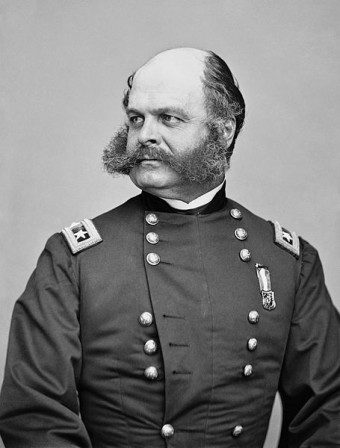Why Sideburns are Named as They Are
Today I found out why sideburns are named as they are.
It turns out, despite this particular brand of facial hair style being around as far back as at least 100 BC (with one of the earliest known instances being in a mosaic of Alexander the Great), sideburns were named after a specific man in the late 19th century.
The man was politician, businessman, and Union Army General, Ambrose Burnside. Burnside sported a slightly unusual facial hair style with particularly prominent “mutton chop” sideburns connected to a moustache, while keeping his chin shaved perfectly clean.
While an extremely poor General, something he himself was well aware of, Burnside’s popularity as a General and later politician, in combination with the fairly unique formation of his whiskers, helped start something of a new facial hair trend. Around the 1870s-1880s, this gave rise to this facial hair style being named “burnsides”.
Within a few years of this, the facial hair down the side of one’s cheeks, rather than being called “mutton chops” as it was at the time in some regions, began being called a modification of “burnsides”, “sideburns”, with the first documented instance of this being in 1887. Presumably the shift was from the fact that this part of the “burnsides” facial hair style was on the sides of the face- and of course, leaving the “burns” part in in homage to the aforementioned style.
Shortly after “sideburns” popped up, an alternate “sideboards” also made its debut, with “boards” thought to have been shortened from “border”, so essentially “side-boarder”, which is a fitting description of the style.
If you liked this article and the Bonus Facts below, you might also like:
- From 1860-1916 the Uniform Regulations for the British Army Required Every Soldier to have a Moustache
- Why Amish Men Grow Beards But Not Moustaches
- Why Testosterone Affects Body Hair Growth
- Shaving Doesn’t Make Your Hair Grow Back Thicker or Faster
Bonus Facts:
- An old 19th century slang term for a man who liked to frequent brothels or otherwise have sex with many women was “beard-splitter”, presumably coming from the fact that people used to commonly refer to not just a certain style of facial hair, but also pubic hair, as a beard (starting around the 17th century).
- The word “beard” came to English via the West Germanic *barthaz, with the ultimate origin being the Proto-Indo-European *bhardh-a-, meaning “beard”.
- Mutton chops, besides being a slab of rib meat cut somewhat perpendicular to the spine, also refers to a style of sideburn where the facial hair tends to grow larger as it extends down towards the chin, with the chin then being shaved. The first known instance of this style of sideburn being named such was around the mid-1860s and is presumed to have been called this due to the shape somewhat resembling the mutton chop cut of meat. The meat itself was first called such in the early 18th century.
- Although examples can be seen all over the map throughout recorded history, sideburns weren’t a terribly popular form of facial hair until around the early 19th century, particularly being popular then in Western Europe among members of the military. From here, the style began to spread throughout the world. Sideburns declined in popularity in the early 20th century, but saw a resurgence with a much more conservative version of them popping back up in the mid-20th century thanks to the likes of James Dean and Elvis Presley. This new version tended to be shaved close to the face, rather than the formerly common mutton-chop version. In stark contrast to sideburns in the 19th century, most often worn by respected military-men, sideburns post-1950s began being seen as a facial hair style of rebels.
- Moustache, mustache, and mustachio are all technically correct spellings to describe hair on the upper lip. Mustachio has relatively recently fallen out of favor for generically describing all moustaches, now more typically referring to particularly elaborate moustaches. Moustache is the most common spelling today in the English speaking world, though North Americans usually prefer mustache.
- The English word “moustache” comes from the French word of the same spelling, “moustache”, and popped up in English around the 16th century. The French word in turn comes from the Italian word “mostaccio”, from the Medieval Latin “mustacium” and in turn the Medieval Greek “moustakion”. We now finally get to the earliest known origin which was from the Hellenistic Greek “mustax”, meaning “upper lip”, which may or may not have come from the Hellenistic Greek “mullon”, meaning “lip”. It is theorized that this in turn came from the Proto-Indo-European root “*mendh-“, meaning “to chew” (which is also where we get the word “mandible”).
- The longest moustache ever recorded was in Italy on March 4, 2010, and measured in at 14 ft. long (4.29 m). The proud owner of that magnificent ‘stache was Indian Ram Singh Chauhan.
- Because of his own ineptitude as a military commander, Burnside twice refused to take command of the Army of the Potomac before ultimately giving in and accepting.
| Share the Knowledge! |
|






3 comments